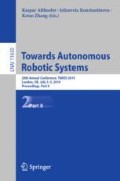Abstract
The idea of this research is to evolve the shape of robots within a swarm, in order for them to work better as a whole. Small robots are not so powerful individually, but when cooperating with each other, by physically hooking together forming a larger organism for example, they may be able to solve more complex tasks. The shape each robot has influences the way they physically interact and, taking advantage of the morphological computation phenomenon, I show that evolving the robots’ morphology in a swarm makes it more efficient for the task of transporting objects, even in comparison to evolving the robot’s controller. In order to fulfill this objective, I have evolved the shape of arm-like structures for the robots’ bodies and their controller separately, and compared the results with control experiments.
Access this chapter
Tax calculation will be finalised at checkout
Purchases are for personal use only
References
Bongard, J.: Embodied cognition: the other morphology. Neuromorphic Eng. (2008). https://doi.org/10.2417/1200812.1420
Bongard, J.: Taking a biologically inspired approach to the design of autonomous, adaptive machines. Commun. ACM 56(8), 74–83 (2013). https://doi.org/10.1145/2493883
Chen, J., Gauci, M., Groß, R.: A strategy for transporting tall objects with a swarm of miniature mobile robots. In: IEEE International Conference on Robotics and Automation (ICRA), pp. 863–869 (2013). https://doi.org/10.1109/ICRA.2013.6630674
Cyberbotics Ltd., Michel, O., Rohrer, F., Heiniger, N., Wikibooks Contributors: Cyberbotics’ Robot Curriculum. Wikibooks (2010)
Deneubourg, J., Goss, S., Sandini, G., Ferrari, F., Dario, P.: Self-organizing collection and transport of objects in unpredictable environments. In: Japan-USA Symposium on Flexible Automation, pp. 1093–1098 (1990)
Dodig-Crnkovic, G.: The info-computational nature of morphological computing. In: Müller, V. (ed.) Philosophy and Theory of Artificial Intelligence, vol. 5, pp. 59–68. Springer, Heidelberg (2013). https://doi.org/10.1007/978-3-642-31674-6_5
Groß, R., Dorigo, M.: Cooperative transport of objects of different shapes and sizes. In: Dorigo, M., Birattari, M., Blum, C., Gambardella, L.M., Mondada, F., Stützle, T. (eds.) ANTS 2004. LNCS, vol. 3172, pp. 106–117. Springer, Heidelberg (2004). https://doi.org/10.1007/978-3-540-28646-2_10
Groß, R., Dorigo, M.: Evolving a cooperative transport behavior for two simple robots. In: Liardet, P., Collet, P., Fonlupt, C., Lutton, E., Schoenauer, M. (eds.) EA 2003. LNCS, vol. 2936, pp. 305–316. Springer, Heidelberg (2004). https://doi.org/10.1007/978-3-540-24621-3_25
Groß, R., Dorigo, M.: Towards group transport by swarms of robots. Int. J. Bio-Inspired Comput. 1(1/2), 1–13 (2009). https://doi.org/10.1504/IJBIC.2009.022770
Hamann, H.: Swarm Robotics: A Formal Approach. Springer, Cham (2018). https://doi.org/10.1007/978-3-319-74528-2
Jin, Y.: Surrogate-assisted evolutionary computation: recent advances and future challenges. Swarm Evol. Comput. 1, 61–70 (2006). https://doi.org/10.1016/j.swevo.2011.05.001
Kube, C., Bonabeau, E.: Cooperative transport by ants and robots. Robot. Auton. Syst. 30, 85–101 (2000). https://doi.org/10.1016/S0921-8890(99)00066-4
Levi, P., Kernbach, S. (eds.): Symbiotic Multi-Robot Organisms: Reliability, Adaptability Evolution. Springer, Heidelberg (2010). https://doi.org/10.1007/978-3-642-11692-6
O’Dowd, P., Winfield, A., Studley, M.: The distributed co-evolution of an embodied simulator and controller for adaptive swarm behaviours. In: IEEE/RSJ International Conference on Intelligent Robots and Systems (IROS), pp. 4995–5000 (2011). https://doi.org/10.1109/IROS.2011.6094600
O’Grady, R., Groß, R., Christensen, A.: Performance benefits of self-assembly in a swarm-bot. In: IEEE/RSJ International Conference on Intelligent Robots and Systems (IROS), pp. 2381–2387 (2007). https://doi.org/10.1109/IROS.2007.4399424
Paul, C.: Morphological computation - a basis for the analysis of morphology and control requirements. Robot. Auton. Syst. 54, 619–630 (2006). https://doi.org/10.1016/j.robot.2006.03.003
Pfeifer, R., Bongard, J.: How the Body Shapes the Way We Think: A New View of Intelligence. The MIT Press (2006). https://doi.org/10.7551/mitpress/3585.001.0001
Winfield, A.F.T., Blum, C., Liu, W.: Towards an ethical robot: internal models, consequences and ethical action selection. In: Mistry, M., Leonardis, A., Witkowski, M., Melhuish, C. (eds.) TAROS 2014. LNCS (LNAI), vol. 8717, pp. 85–96. Springer, Cham (2014). https://doi.org/10.1007/978-3-319-10401-0_8
Zambrano, D., Cianchetti, M., Laschi, C.: The morphological computation principles as a new paradigm for robotic design. In: Opinions and Outlooks on Morphological Computation, Chap. 19, pp. 214–225 (2014). https://doi.org/10.13140/2.1.1059.4242
Author information
Authors and Affiliations
Corresponding author
Editor information
Editors and Affiliations
Rights and permissions
Copyright information
© 2019 Springer Nature Switzerland AG
About this paper
Cite this paper
Meyer, J. (2019). The Impact of the Robot’s Morphology in the Collective Transport. In: Althoefer, K., Konstantinova, J., Zhang, K. (eds) Towards Autonomous Robotic Systems. TAROS 2019. Lecture Notes in Computer Science(), vol 11650. Springer, Cham. https://doi.org/10.1007/978-3-030-25332-5_34
Download citation
DOI: https://doi.org/10.1007/978-3-030-25332-5_34
Published:
Publisher Name: Springer, Cham
Print ISBN: 978-3-030-25331-8
Online ISBN: 978-3-030-25332-5
eBook Packages: Computer ScienceComputer Science (R0)

